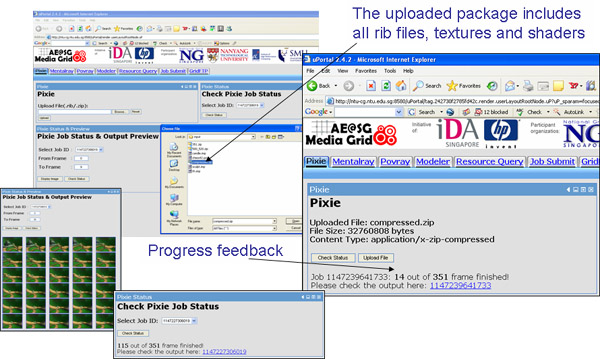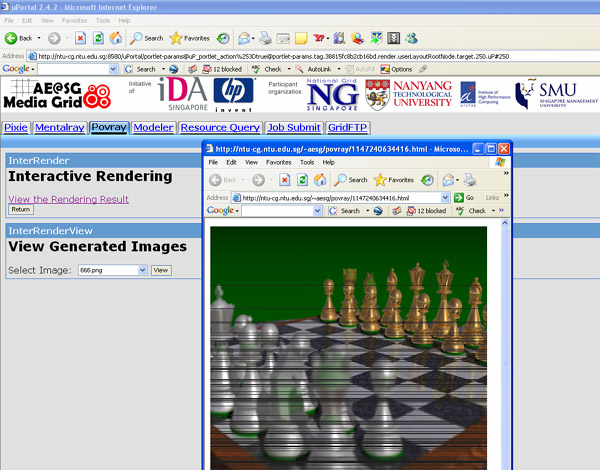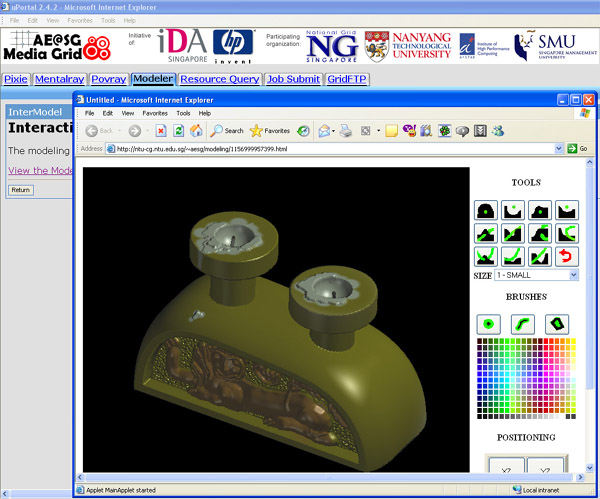
Research grant AE@SG,
Work Package 2 "Media Grid Applications", 2004-2006
Principal investigator: Alexei Sourin
Contributed Researchers:
Anthony Chong (Research Asistant NTU, 2004-2006, PhD student NTU 2004-2006)
Konstantin Levinski (Research
Assistant NTU, 2004-2006)
Last time updated on 28 March, 2010

Rendering computer animation frames is a very time consuming job. Using parallel computing on clusters and so-called render farms is a common solution to this problem. In this project we use Grid computing for computer animation rendering. We developed a framework for Grid rendering services. It allows for two methods of accessing the Grid: direct rendering and rendering through a portal access. Direct rendering allows for an immediate returning of the rendered images where the images can be checked and any fine-tuning of the images can be performed by terminating the current rendering process and re-sending the animation sequences frame back to the rendering Grid again. Portal access allows for an easy accessing to the render Grid and for batch sending of the animation sequences frames. Returned images can be stored in the storage server for later retrieval. This framework is built based on open source software and the total cost of ownership is substantially reduced. We have also devised and implemented a loseless 3D compression algorithm that enables us to transferring across the Internet gigabytes of scene representation files (Renderman (.rib) and mental images (.mi)).

Submission of the animation job to Grid from Maya

Submission of the animation job to Grid from the Media Grid web portal
Publications:
Lee BS, Sourin A, Chia LT, Chan KY, Hung T, Ho QT, Wei J, Oh D, Miller S, Zhang J, Chong A, Levinski K. Rendering-On-Demand Service Across Heterogeneous Grid Environment. Proc 3rd Int w/s on Grid Computing and Applications, GCA 2007. Biopolis, Singapore, 5 - 8 June 2007, World Scientific, pp 91-103, 2007.
Chong A, Sourin A, Levinski K, Levinski K. Grid-based computer animation rendering. Proc. ACM Graphite'06, Kuala Lumpur, Malaysia, 39-47, 2006.
Chong A, Sourin A, Lee F, Levinski K. A Method and System for Compressing and Decompressing Data. Patent filed in Singapore 19 Oct 2006, ref. 200607321-7.
Visualization and Shape Modeling on Grid
Free-form shape modeling is a method of making geometric shapes in any possible way rather than from a finite set of basic shapes. Such freedom of modeling requires new shape representations capable of expressing arbitrary modifications. A shape capable of free-form modifications can be efficiently defined by an explicit function g=f(p) that defines a scalar field over the R3 space, where point pÎR3. The surface of the shape is defined with an equation f(p)=0. Using this representation, we can simulate various crafting techniques such as sculpting, carving, embossing, engraving. Hence, the original shape and thousands of interactive modifications applied to it are represented by mathematical functions. The resulting function-defined model is very compact compared to the commonly used shape definitions with polygons and voxels. However, thousands of interactive operations make the defining function so complex that its rendering becomes non-interactive when just one processor is used. In this project we use Computational Grid to get the required computational power for high-precision free-form shape modeling. The model compactness allows us to create optimal infrastructure for distributing work between processing nodes. We propose a novel parallel surface extraction algorithm which performs a non-uniform sampling of the defining function so that only the points located near the surface of the shape are taken into consideration. We implemented an interactive free-form shape modeling tool available from the Media Grid portal. It supports shape modification, visualization with arbitrary precision and dynamic load-dependent allocation of computing resources during the modeling session.
POV -Ray on Grid

Interactive Shape Modeling
Goals
To use Grid for working with function-defined 3D shapes when a single computer computational power is not sufficient.
Deliver the application through the rich media portal directly to the users, without installing additional software
Methods
Java3D web-based interface to receive user commands and visualize the model
Real-time communication link between computing nodes and the interface

Publications:
A.Chong, K.Levinski and A.Sourin. Interactive Grid-based Free-Form Shape Modeling. IEEE CCGrid, 2006, 253-256.
Copyright © 2006 Alexei Sourin.
This material may not be published, modified or otherwise redistributed in whole or
part without prior approval.